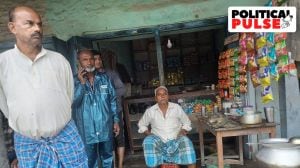Remains of a fort discovered near Pak border may unlock secret of the Rann
Discovery is likely to shed new light on how the quake of 1819 formed the western borders.
A former ISRO scientist and three researchers have found the ruins of a pentagon-shaped fort near the Indo-Pak border that probably sank in a powerful 19th century earthquake. This discovery is likely to shed new light on how the quake of 1819 formed the western borders of one of the most inhospitable terrains on the planet the Great Rann of Kutch.
In February 2010,P S Thakker,who has since retired from ISROs Space Applications Centre in Ahmedabad,peered over Google Earth images as was his habit,and detected what looked like the ruins of a fort a few kilometres from the international border.
I discussed it with many people,but they did not believe me at first, Thakker told The Sunday Express. But he did not give up. He spoke to other academics he knew,and they approached the Border Security Force (BSF) for permission to visit the area. It was granted.
The fort of Basta Bandar was briefly mentioned by Englishman T G Carless in his Memoir to accompany the survey of the Delta of the Indus, in 1837,published after the quake of 1819. The ruined fort… which formerly belonged to the Raos (princes or chieftains) of Kachchh… was destroyed by the Sindians during their wars with those princes, Carless recorded.
Accompanied by BSF Crocodile Commandos on speedboats,Thakker and three others N Juyal of the Physical Research Laboratory,M G Thakkar and Mamata Ngangom of Kutch University reached Basta Bandar on February 4,2011.
We spent two to three hours at the site,examining it and taking photographs. We also took some samples, said M G Thakkar,Dean of Sciences and Head of Department of Earth and Environmental Science at Kutch University.
The find has been made public in a paper published in the latest issue of Current Science (July 25) where Thakkar describes the pentagonal walls protruding 20-40 cm above tidal mud flats… which get flooded during spring tide… The dimensions of the bastions and gate,thickness of the wall suggest that it was a robust structure compared to its modern counterpart at Lakhpat.
He told The Sunday Express that it is unlikely the forts wall were flooded by silt from the many creeks there because the walls of most forts in this part of the country are at least 20 feet tall.
That 15 to 18 feet can be buried by silting in less than 200 years is unlikely,so the fort and nearby areas must have been sunk by an earthquake, he said,adding that thermoluminescence dating of potsherd samples recovered from the fort are 214 years old.
This small piece of information has thrown light on a much larger phenomena. The 7.9-magnitude quake of 1819 not only created the Allah Bund,an 80 km-long,16 km-wide strip of Rann sediments,but also buckled the landmass that lies to the bunds southwest.
West to east,the terrain is like a table cloth pushed from one side a depression in the west where the sunk Basta Bandar lies,rising at a place called Sunda Uplift further north-east,then somewhat plain for about 20 km till it dips at Sindri Depression,only to rise again at Allah Bund.
This had large consequences for the regions rivers. Once connected to the Indus and reaching the Arabian Sea,they were used for trade between Kutch and Sindh. The Allah Bund blocked the waters of Nara,an Indus tributary,and a juvenile drainage network was formed.
According to Thakkar,the relatively small network means the region is young since the waters have not yet made incisions to change the landscape. It remains separated from the Kori Creek in the west whose waters enter the Sindri Depression during tidal fluctuations in the Arabian Sea.
With the Allah Bund restricting flow,freshwater stopped flowing into western Kutch. The greatest example of this is that Lakhpat used to have vast rice fields. That stopped, Thakkar said.



- 01
- 02
- 03
- 04
- 05




























